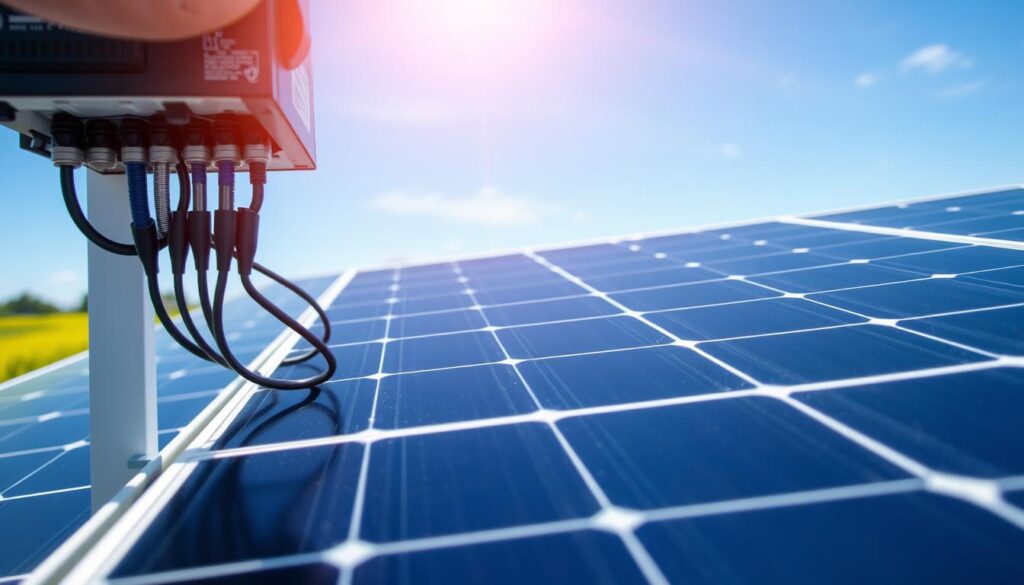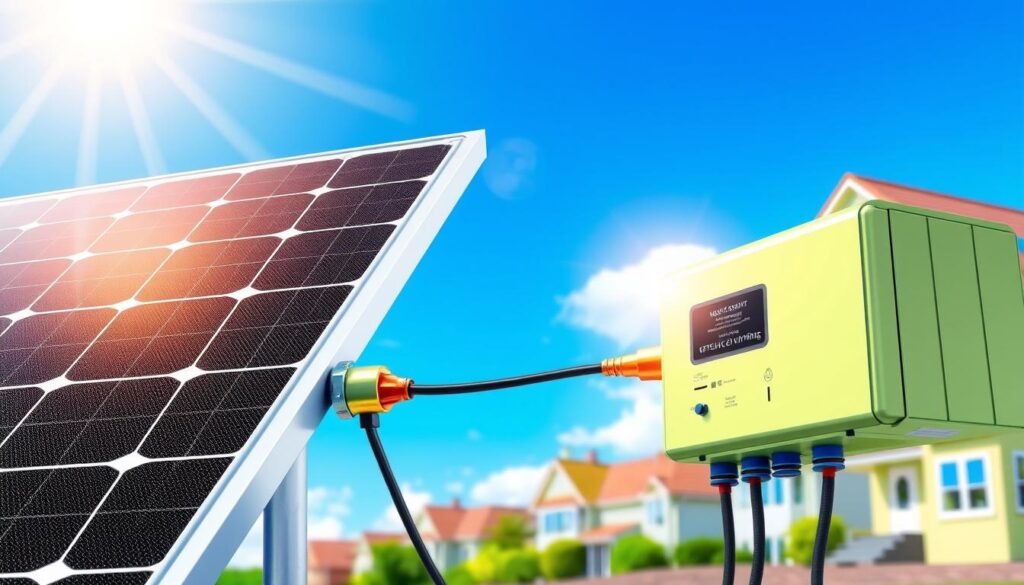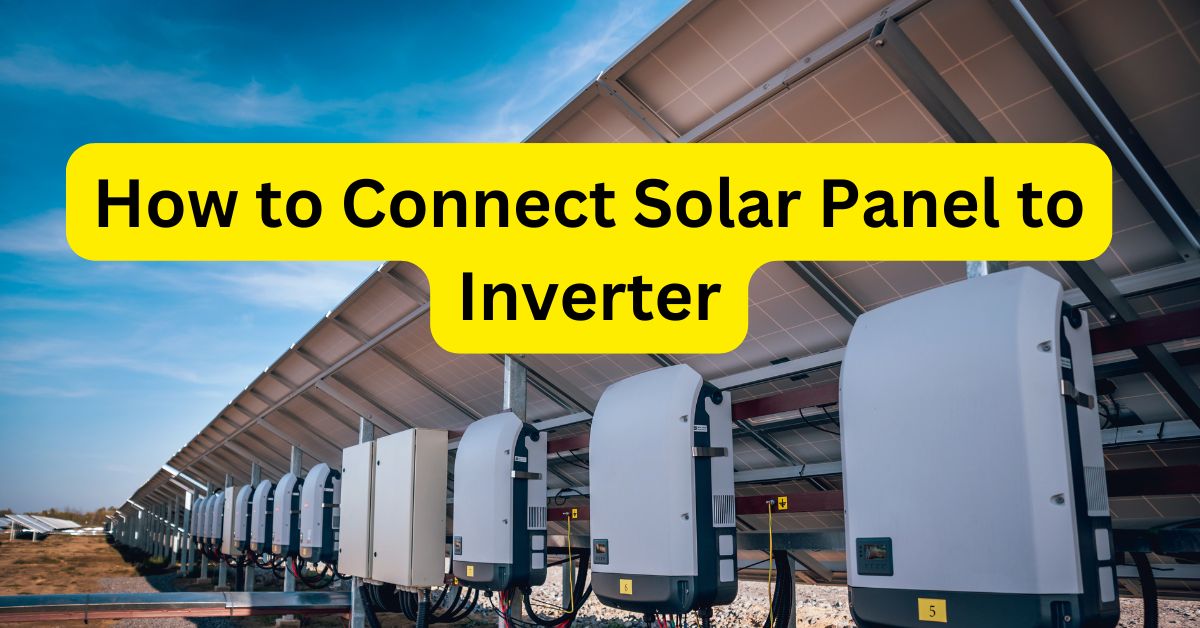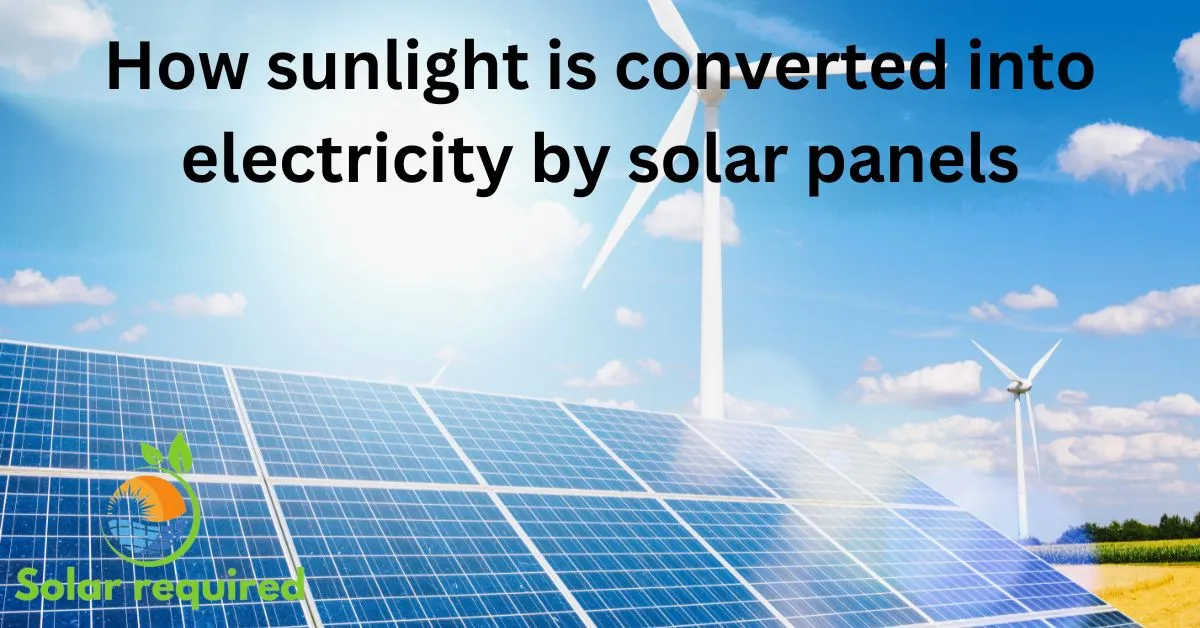Connecting solar panels to inverters is key to using solar energy wells. I’ve learned that knowing how to link a solar panel to an inverter is crucial. This step is important for getting the most energy from the sun.
It helps move energy from the panels to our electrical systems. This makes using green energy better. I want to share how connecting panels to inverters boosts our solar system’s efficiency.

Key Takeaways
- Understanding the role of inverters in solar energy systems is essential.
- Connecting solar panels to inverters significantly impacts energy efficiency.
- Proper installation can maximize the performance of your solar setup.
- Familiarity with industry guidelines aids in safe and effective connections.
- User experiences provide valuable insights into best practices.
Understanding Solar Panels and Inverters
It’s important to know how solar panels and inverters work together. Solar panels turn sunlight into electricity. Inverters then change this electricity into a form we can use at home or in businesses. This part explains what solar panels are and why inverters are so crucial.
What Are Solar Panels?
Solar panels use sunlight to make electricity. They are made of many solar cells, usually from silicon. There are two main types:
- Monocrystalline Panels: These panels are very efficient and look sleek. They’re made from single-crystal silicon.
- Polycrystalline Panels: These panels are made from many silicon crystals. They cost less but are slightly less efficient than monocrystalline panels.
Both types have their benefits. They help solar energy systems become more popular in homes and businesses.
What Are Inverters?
Inverters are key in solar systems. They turn DC electricity from solar panels into AC electricity. We use AC in our homes to connect to the grid. There are different types of inverters:
- String Inverters: These are affordable and common. They work best when sunlight hits all panels evenly.
- Microinverters: These are great for areas with partial shade. They let each panel work at its best.
- Power Optimizers: They mix the benefits of string inverters and microinverters. They help each panel produce more energy.
Choosing the right inverter is vital. It makes sure the electricity we get is used efficiently.
Importance of Connecting Solar Panels to Inverters
Knowing how important a good solar panel is to inverter connection is key for those thinking about solar energy. This link is crucial for turning sunlight into electricity we can use. The better this process, the more solar power we can use and enjoy its benefits.
Energy Conversion Process
The energy conversion process starts when sunlight hits the solar panels, creating DC electricity. An inverter then changes this DC to AC, which is what our homes use. This step is vital because most of our appliances need AC to work.
With a smooth solar panel to inverter connection, my solar system works better. This means I get to use all the energy it makes.
Benefits of a Proper Connection
A good connection between solar panels and inverters brings many benefits of solar connection. These include:
- More energy efficiency means more electricity we can use.
- Lower electricity bills because we use less grid power.
- A smaller carbon footprint helps the environment.
By making sure my solar panel to inverter connection is right, I get these benefits. Plus, I help make energy more sustainable.
| Benefit | Description |
|---|---|
| Enhanced Energy Efficiency | Maximizes the amount of energy converted from sunlight to electricity. |
| Reduced Electricity Bills | Minimizes dependence on traditional power sources, lowering monthly expenses. |
| Positive Environmental Impact | Supports clean energy efforts by decreasing reliance on fossil fuels. |
Recent Post: Proper Solar Panel Spacing Guide
Connecting a solar panel to an inverter is key to turning solar energy into electricity you can use. This guide will show you what tools and equipment you need. It also includes step-by-step instructions to make the process easy. I’ll share tips to help you connect successfully and avoid mistakes.
Necessary Tools and Equipment
Before you start, make sure you have these tools and equipment:
- Solar panel
- Inverter that works with your solar panel
- Right cables (usually for solar use)
- Connectors (like MC4 connectors)
- Wire strippers
- Multimeter
- Safety gear (gloves and goggles)
- Mounting hardware
Step-by-Step Instructions
Here are the steps to connect your solar panel to an inverter:
- Site Assessment: Pick a spot for your solar panels that gets a lot of sunlight.
- Panel Mounting: Use mounting hardware to secure the solar panels on the chosen surface.
- Wiring: Connect the solar panel cables to the inverter with the right connectors. Make sure the positive and negative terminals are matched.
- Inverter Placement: Place the inverter in a shaded area to keep it cool. Make sure it has good airflow.
- Final Connections: Connect the inverter to your electrical system. Follow local codes and the manufacturer’s guidelines.
- Testing: Use a multimeter to check the voltage. This confirms the connection is working.
Following these tips can avoid common problems and make your solar energy system more efficient. Understanding how to connect a solar panel to an inverter is crucial for a successful renewable energy setup.
| Step | Description |
|---|---|
| 1 | Site Assessment |
| 2 | Panel Mounting |
| 3 | Wiring |
| 4 | Inverter Placement |
| 5 | Final Connections |
| 6 | Testing |
Choosing the Right Inverter for Your Solar System
Choosing the right inverter for your solar system is key. It affects how well your solar energy system works. There are many inverter types, each suited for different needs.
Different Types of Inverters
The main types of inverters are:
- String Inverters: These connect many solar panels. They’re affordable for big setups but might not work well with shaded panels.
- Microinverters: These are for each panel. They make the most of each panel’s energy, great for shaded areas but costs more.
- Power Optimizers: They work like microinverters but use a central inverter. They’re a good middle ground for cost and performance, especially in shaded areas.
Factors to Consider
When picking an inverter, think about these things:
| Factor | Considerations |
|---|---|
| Efficiency Ratings | A higher efficiency means more energy conversion from sunlight to electricity. |
| Warranties | Longer warranties suggest confidence in the product’s reliability and performance. |
| Cost | Budget constraints will influence the choice between various inverter types. |
| System Size | Evaluate if the inverter capacity can handle my anticipated energy needs. |
Solar Panel Wiring with Inverter
Setting up a solar energy system starts with wiring solar panels to an inverter. This step is key to making the energy usable. Knowing how to wire panels to an inverter is crucial. I’ll explain different wiring diagrams and schemes to improve your solar system’s safety and efficiency.
Wiring Diagrams Explained
Accurate wiring diagrams are essential for solar panel wiring. They show how electricity flows from panels to the inverter. They highlight important parts like fuses and switches. Let’s look at some important wiring diagrams:
- Series Wiring: This method links panels in a line. It boosts voltage but keeps the current steady, great for high-voltage systems.
- Parallel Wiring: This connects panels at the same voltage, increasing current. It’s good for systems where shading is a problem.
- Combiner Box Wiring: This setup connects many panels to one point before the inverter. It makes wiring easier and installation faster.
Common Wiring Schemes
There are various setups for solar systems, depending on their size and type. Here are some common ones used in homes and businesses:
| Configuration Type | Advantages | Disadvantages |
|---|---|---|
| Series | Increases voltage; fewer connections to manage. | Single panel failure affects entire string performance. |
| Parallel | Single panel failure affects the entire string performance. | Requires larger wire gauge to handle increased current. |
| Grid-Tied | Simplifies installation; often receives incentives from utility companies. | May not provide power during outages unless a backup system is in place. |
Choosing the right wiring technique is key to a solar system’s efficiency. By picking the best setup, I can ensure my system works well and safely.
Solar System Inverter Setup: A Comprehensive Overview
It’s important to know about AC vs. DC connections and where to install your inverter. This knowledge helps you choose the right setup for your solar system. The right spot for your inverter can also make it easier to maintain and improve its performance.
Connection Types: AC vs. DC
Choosing between AC and DC connections is key when setting up your solar system inverter. Here’s a comparison of the two:
| Connection Type | Advantages | Best Use Cases |
|---|---|---|
| AC (Alternating Current) | Works well with standard home appliances Easy to connect to the grid Great for sending power over long distances | Residential solar setups, grid-tied systems |
| DC (Direct Current) | More efficient over short distances Perfect for systems with battery backup Less energy lost during conversion | Off-grid solar systems, installations with battery backup |
Installation Locations
The location of your inverter affects your solar system’s efficiency. Here are things to consider for indoor and outdoor setups:
- Indoor Installation: This keeps your inverter safe from the weather, reduces wear, and boosts safety.
- Outdoor Installation: Gets more sunlight and needs less wiring. But, it faces harsh weather.

Best Practices for Solar Panel Inverter Connection
Connecting solar panels to inverters needs the right approach. This ensures safety, follows rules, and keeps the system working well. Here are some key tips for safety and efficiency.
Ensuring Safety and Compliance
Keeping safety first during setup and upkeep is essential. Here are the important steps:
- Always follow local electrical codes when setting up systems.
- Make sure all gear is UL-listed and fits your needs.
- Put in disconnect switches for quick shutdown in emergencies.
- Do regular checks for wear and hazards.
These steps help keep things safe, cutting down on electrical problems and dangers.
Maximizing Efficiency
To get the most from solar panels, keeping them efficient is key. Here are some upkeep tips:
- Use software to watch system performance and spot drops.
- Keep solar panels clean to avoid dust and debris blocking sunlight.
- Make sure all connections are tight and corrosion-free for the best flow.
- Get regular checks from pros to fix ongoing issues.
By following these tips, you can make sure your system runs at its best, boosting energy output.
Using these best practices for solar panel inverter connection boosts confidence in solar energy systems. It also promotes safety and efficiency.
Troubleshooting Solar Panel to Inverter Connection Issues
The link between solar panels and inverters can sometimes be tricky. I’ve seen a few common issues that might slow down your system. Fixing these problems quickly helps your system work better and saves more energy.
Common Problems and Solutions
There are a few main problems when connecting solar panels to inverters. Here are some common issues and how to solve them:
- Communication Errors: This happens when the inverter can’t get signals from the panels. Make sure all wires are tight and correctly connected.
- Voltage Issues: If the voltages don’t match, your system won’t work well. Use a multimeter to check the voltages. If they’re off, adjust the panel connections.
- Poor System Performance: If your system isn’t producing enough power, it might be due to shading, damage, or setup mistakes. Clean the panels and check for damage or blockages regularly.
When to Call a Professional
Some problems need a pro’s help. You should call a professional if:
- Your system keeps underperforming, even after trying to fix it.
- You see electrical parts you don’t know how to handle or that look dangerous.
- The inverter keeps showing error codes, which means there’s a technical problem.
Acting fast to solve these common issues can make your solar system last longer and work better.
Connecting Solar Panel to Battery Inverter
Adding a battery inverter to my solar setup boosts energy management and efficiency. The setup for solar battery integration lets me save extra energy for when the sun isn’t out. Here, I’ll explain how to connect solar panels to a battery inverter and the benefits it offers.
Setup Steps
To connect a solar panel to a battery inverter, follow these steps:
- Gather the needed tools and parts, like a battery inverter, solar panels, batteries, and wiring.
- Make sure safety first by turning off any power before starting.
- Connect the solar panels to the charge controller, making sure the polarity is right.
- Link the charge controller to the batteries for safe energy storage.
- Connect the battery inverter to the batteries for efficient energy conversion.
- Test the system to check all connections are secure and working.

Benefits of Battery Integration
The benefits of battery inverters are many. Battery integration offers:
- Energy storage for nighttime use, cutting down on grid reliance.
- Backup power during outages, giving peace of mind.
- Efficient use of solar energy by storing extra power made during the day.
Different battery types like lithium-ion and lead-acid have their benefits for solar use. Each type suits different energy needs and budgets.
| Battery Type | Energy Density | Cycle Life | Cost |
|---|---|---|---|
| Lithium-Ion | High | 2000-7000 cycles | Higher |
| Lead-Acid | Medium | 500-1500 cycles | Lower |
By connecting solar panels to a battery inverter, I maximize solar energy use. This ensures my energy system is sustainable and reliable.
D.I.Y. Solar Panel Inverter Installation Tips
Trying to install a DIY solar panel inverter can be very rewarding. It’s important to follow the right steps for safety and to work well. I’ll share some key tips, focusing on safety, and a simple step-by-step guide to help you.
Safety Precautions to Take
Before you start, it’s vital to follow safety rules. Here are some important safety tips:
- Always wear safety goggles and gloves to protect against electrical hazards.
- Ensure the work area is dry and clear of any clutter.
- Disconnect the power supply before handling any wiring.
- Double-check voltage levels using a multimeter.
- Follow the manufacturer’s instructions for all equipment.
- Have a fire extinguisher nearby in case of emergencies.
Step-by-Step Installation Guide
Using a structured approach can help with the installation. Here are the basic steps for a successful setup:
- Assess your solar energy needs: Calculate how much power you need and select an appropriate inverter.
- Gather necessary tools: Prepare tools like a screwdriver, wire cutters, and electrical tape.
- Install the solar panels: Position them correctly to maximize sunlight exposure and connect them to the inverter.
- Wire the inverter: Carefully follow the wiring diagrams, connecting the panels to the inverter terminals.
- Connect to the battery (if applicable): If you are using battery storage, connect the inverter to the battery system.
- Test the system: Once connected, check all connections for security and ensure the system is functioning properly.
You can also check: Foldable Solar Panel: What you need to know
Solar Panel to Inverter Wiring: Code Compliance and Standards
When you work on solar panels to inverter wiring, following local electrical codes is key. Each area has its own rules for solar systems. These rules help ensure your system works well and is safe.
Understanding Local Codes
Local electrical codes set the rules for wiring and installation. They cover things like wire sizes and grounding. It’s smart to check these codes before you start.
Local bodies publish guides on what’s allowed. Knowing this can save you from mistakes and ensure your system is up to code.
Importance of Professional Guidance
While you can learn a lot about wiring codes, it’s complex. Getting help from a pro is often a good idea. Licensed electricians know the codes inside out.
They make sure your installation meets all standards. Their experience keeps you safe and could save you from fines.
Getting professional help makes the process smoother. It lets you enjoy solar energy without worrying about legal issues.
| Aspect | Details |
|---|---|
| Local Codes | Guide installation practices and safety measures |
| Compliance | Avoid fines and ensure system safety |
| Professional Guidance | Expertise in navigating regulations and installation |
| Installation Efficiency | Quicker setup and enhanced system reliability |
Conclusion
Connecting solar panels to inverters is key for any solar energy system. I’ve shared how important it is to do it right. It boosts system efficiency and meets safety standards.
The perks of solar connections go beyond saving money. They help us move towards a greener future. They also make the most of our solar setup.
With what you’ve learned, you can tackle your solar projects with confidence. Making sure your solar panels and inverters are connected well will make your system better. This effort will save you money and help the planet.
Remember, a well-built solar energy system has many benefits over time. With the right knowledge and practice, you can make a renewable energy solution. It will benefit you and the community too.
FAQ
How do I connect a solar panel to an inverter?
First, make sure you have the right tools and safety gear. Attach the positive cable from the solar panel to the inverter’s positive terminal. Then, connect the negative cable to the inverter’s negative terminal. Ensure all connections are secure for safety and efficiency.
What is the importance of connecting solar panels to inverters?
Connecting solar panels to inverters is key for energy conversion. It changes DC electricity from solar panels to AC electricity for home use or grid feed. A good connection boosts efficiency and increases energy output.
What tools do I need for a solar panel inverter connection?
You’ll need cables, connectors, a multimeter, safety gloves, and tools like wire strippers and screwdrivers. Having the right tools saves time during installation.
Can I connect solar panels directly to a battery without an inverter?
Yes, you can connect solar panels to a battery with a charge controller. But, you need an inverter to convert DC energy to AC for household use.
What are the common problems encountered with solar panel to inverter connections?
Issues include wrong wiring, loose connections, or low voltage. These problems can stop the inverter from working right. Always check your connections and use a multimeter to troubleshoot.
Are there different types of inverters for solar systems?
Yes, there are string inverters, microinverters, and power optimizers. Each has its benefits and best uses based on system size and energy needs.
How do I ensure my solar panel inverter connection complies with local codes?
To meet local codes, learn about local electrical rules for solar installations. Talking to a pro or using resources from local bodies can help you follow these rules.
What are the benefits of integrating batteries into my solar system?
Adding batteries to your solar system lets you store energy for night use or during outages. This boosts your system’s reliability and efficiency, giving you more grid independence.
Is a DIY solar panel inverter installation safe?
DIY installation can be safe with careful planning and safety steps. But, if unsure, it’s best to get a pro to ensure safety and code compliance.


